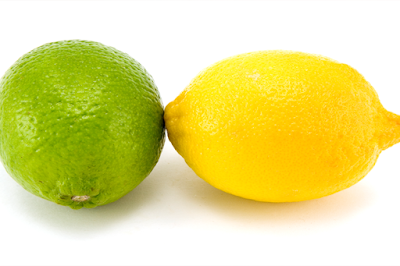Do You Know The Difference Between Lemon And Lime
Lemon and lime are two different genetic types of fruit with similar characteristics.
Some experts believe that the lemons were created as a hybrid of lime and citron – a large, thick root with citrus fruits.
Lemon and lime, as well as oranges, tangerines, citron and grapefruit, belong to a wider category of citrus fruits and are cultivated around the world. However, lemon, formally known as Citrus, is usually grown in moderate climates, while lime, or Citrus aurantifolia, grows mainly in tropical and subtropical regions.
Fresh and processed forms of lemon and lime are used in many different industries.
These fruits are well known for their sour taste and are presented in various culinary applications around the world. They can be used for cooking, food preservation or for improving the taste.
Essential lemon and lime oil are often used for cosmetic and medical purposes, and are found in many household cleaning products, due to their smell and antibacterial properties.
Common features:
Although lemon and lime are different fruits, they share the same characteristics, especially when it comes to their nutritional value and potential health benefits.
Nutritional value
Vitamin C, which is well known for its antioxidant properties and plays a major role in maintaining a healthy immune system, is one of the main nutrients found in these citrus fruits.
Difference Between Lemon And Lime
Lemons provide more vitamin C than limes, but both of them contribute significantly to this diet in vitamins, and contain many other plant compounds with known antioxidant, anti-inflammatory and antibacterial properties.
Multiple studies suggest that these compounds can play a role in preventing heart disease and certain types of cancer, including breast and colon cancer.
Generally, lemons, unlike limes, offer slightly more vitamins and minerals, including potassium, folic acid, and vitamin B6.
A study found that citric acid (a specific compound found in lemons) has a protective effect against inflammation in the brain and liver.
Appearance and taste
Perhaps one of the most obvious differences between lemon and lime is the look.
Lemons are usually yellow in color, while the lime is green in color. However, certain types of lime with ripening are yellowing, making the difference between them a bit tougher.
The flesh of lime is smaller and cheek than the lemon. The size may vary, but it is usually 3 (three) to 6 (six) centimeters in diameter.
For comparison, the lemons have a diameter of 7 (seven) to 12 (twelve) centimeters. And have a more oval or elongated shape.
In terms of taste, these two citrus fruits have a similar acidic taste. And eating lemon or lime, in itself, will result in the same pronounced facial expression.
However, lemons tend to err on the side of the slightly sweet. While the taste of the lime is usually crueler. Lemons are sweeter and larger than limes, while limes are more exaggerated.
When it comes to cooking, the two planks are used in similar ways. They make excellent accessories for dressings for salad, sauces, marinades, drinks and cocktails. The choice is a work of taste.
As the lime is sourer, it is more commonly used for salty dishes. While lemons are also used in salty and sweet dishes.
These two types of citrus fruits can be safely used alternately in different cooking scenarios.
Lemon and lime, as well as oranges, tangerines, citron and grapefruit, belong to a wider category of citrus fruits and are cultivated around the world. However, lemon, formally known as Citrus, is usually grown in moderate climates, while lime, or Citrus aurantifolia, grows mainly in tropical and subtropical regions.
Fresh and processed forms of lemon and lime are used in many different industries.
These fruits are well known for their sour taste and are presented in various culinary applications around the world. They can be used for cooking, food preservation or for improving the taste.
Essential lemon and lime oil are often used for cosmetic and medical purposes, and are found in many household cleaning products, due to their smell and antibacterial properties.
Common features:
Although lemon and lime are different fruits, they share the same characteristics, especially when it comes to their nutritional value and potential health benefits.
Nutritional value
Vitamin C, which is well known for its antioxidant properties and plays a major role in maintaining a healthy immune system, is one of the main nutrients found in these citrus fruits.
Difference Between Lemon And Lime
Lemons provide more vitamin C than limes, but both of them contribute significantly to this diet in vitamins, and contain many other plant compounds with known antioxidant, anti-inflammatory and antibacterial properties.
Multiple studies suggest that these compounds can play a role in preventing heart disease and certain types of cancer, including breast and colon cancer.
Generally, lemons, unlike limes, offer slightly more vitamins and minerals, including potassium, folic acid, and vitamin B6.
A study found that citric acid (a specific compound found in lemons) has a protective effect against inflammation in the brain and liver.
Appearance and taste
Perhaps one of the most obvious differences between lemon and lime is the look.
Lemons are usually yellow in color, while the lime is green in color. However, certain types of lime with ripening are yellowing, making the difference between them a bit tougher.
The flesh of lime is smaller and cheek than the lemon. The size may vary, but it is usually 3 (three) to 6 (six) centimeters in diameter.
For comparison, the lemons have a diameter of 7 (seven) to 12 (twelve) centimeters. And have a more oval or elongated shape.
In terms of taste, these two citrus fruits have a similar acidic taste. And eating lemon or lime, in itself, will result in the same pronounced facial expression.
However, lemons tend to err on the side of the slightly sweet. While the taste of the lime is usually crueler. Lemons are sweeter and larger than limes, while limes are more exaggerated.
When it comes to cooking, the two planks are used in similar ways. They make excellent accessories for dressings for salad, sauces, marinades, drinks and cocktails. The choice is a work of taste.
As the lime is sourer, it is more commonly used for salty dishes. While lemons are also used in salty and sweet dishes.
These two types of citrus fruits can be safely used alternately in different cooking scenarios.



